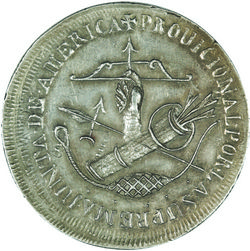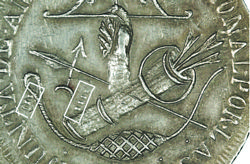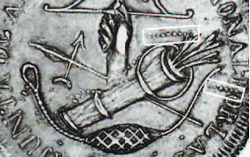The First Issue of the Supreme Junta of Zitácuaro
by Max A. Keech
In August of 1811 the most important coinage of the War for Independence, and arguably the most historic of Mexico, was created by the Supreme Junta at Zitácuaro. For the first time the Mexican national emblem of an eagle, perched on a cactus, appears. It is an odd looking eagle and the cactus rises from a three-arch bridge. On the reverse the weapons of the largely Indian and Mestizo army are shown, a bow and arrow, quiver, spear and sling. Little more is known about this “infant” Mexican national issue and much of what we think we know may not be correct! For instance, did you know that the eagle is not an eagle at all?For this contention, see Max A. Keech, “The First Issue of the Supreme Junta of Zitacuaro and Theories on Early Mexican Symbolism” in USMexNA journal, March 2012 (Available in the USMexNA online library) Or that this issue was not struck at Zitácuaro?
Historical Context
On 16 September 1810, Father Miguel Hidalgo tolled the bells of Dolores Chapel, setting the War for Independence in motion. His army was more of a mob in many ways, swelling with angry, undisciplined and largely illiterate peasants looking for revenge against Spanish oppression. Within two weeks they overwhelmed Guanajuato and a month later, on 30 October, defeated a disciplined 7,000 man army led by Trujillo (with Colonel Agustín Iturbide in attendance) in the bloody battle of Los Cruces. On 17 January 1811, four months after the uprising began, the Royalist Calleja defeated Hidalgo’s mob of 100,000 with 6,000 well trained men at the battle of Calderón. Pursuit followed and on 21 March Hidalgo was betrayed by Elizondo. Hidalgo together with Allende, Aldama and Jiménez were captured at Bajan. Hidalgo’s Secretary-General, Ignacio López Rayón, and Lieutenant-Colonel José María Liceaga had stayed behind at Saltillo and avoided capture. On 15 April Rayón assumed leadership of the insurgency and would remain its leader for most of the next four years until the movement was largely extinguished by the Spanish in 1815.
Following Hidalgo’s capture, Rayón spent April in Zacatecas. In the face of Calleja’s advance he dispersed his troops and demoralized officers and retired to the rugged hills near Valladolid, Michoacán. During the late spring and summer of 1811, no major cities were under insurgent control but the rebellion was growing and numerous bands operated openly in the countryside. From Valladolid to Toluca, the zealous Spanish military commander, Captain Juan Bautista de la Torre, tried to suppress the “bandits” and open the highway. To do so, he needed to pacify the remote town of Zitácuaro which still remained in insurgent control under the farmer and landowner, Benedicto López. Zitácuaro was inherently defensible, surrounded by tall mountains and approachable only through three narrow canyons. On 22 April de la Torre made the mistake of attacking and paid for it with his life. The defeat was complete with the rebels capturing all the enemy’s arms and 300 prisoners.
Recognizing the significance of this event and Zitácuaro’s potential as the insurgent capital, Rayón rushed to join López who willingly ceded control. Rayón immediately began erecting fortifications in anticipation of the Spanish response. A moat was dug, ramparts were built and a foundry established to cast cannon. On 22 June the Spanish Commander Empáran attacked Zitácuaro and was defeated by Rayón’s forces. The fortifications continued until an impenetrable fortress was established which could serve as the insurgent’s first capital.
Rayón was a lawyer and organizer who envisioned uniting the various insurgent groups under one command with a clear message which would attract intellectual as well as mass support. The loss at Calderón demonstrated that unorganized numbers were not enough to defeat the Spanish. An organized and structured way forward was needed to achieve independence. Rayón’s plan included a government seated in Zitácuaro with a trained army under a central command. In correspondence with Morelos, he shared this vision and received Morelos’ support to convene a National Assembly, establish a charter and elect a Supreme Junta.
On 18 August 1811 the Assembly was convened and Rayón elected president of the three-member Junta. Also elected were José María Liceaga and the priest, José Sixto Verduzco, a representative of Morelos. An act was passed pledging respect for the rights of Church, the imprisoned Ferdinand VII and Liberty. Circulars were sent to all areas under insurgent control requiring an oath of allegiance from all chiefs, troops and inhabitants. Conscious of the power of the press, a weekly circular Ilustrado Americano was published to spread the insurgent message.
First coinage of the Supreme Junta
While the historic political and military events of this period are well documented, there is very little written about this important coinage. The rarity of the struck coinage and lack of concurrent documentation has perhaps frustrated a closer look in the past. As a point in fact, the struck issue was unknown to Pradeau when he published his ground breaking Numismatic History of Mexico in 1938. Because of the lack of concurrent documentation, a certain amount of reasoned interpretation (and sometimes speculation) is necessary to create this narrative and for this I ask your indulgence. I would also welcome and encourage other thoughts, research and opinions. This issue is too important to have been left nearly untouched for 200 years.


In August of 1811 Rayón had dies prepared for an independent coinage. For the first time, an eagle atop a cactus, sitting on a bridge, is presented as the national symbol. The legend contains the familiar “FERDIN VII DEI GRATIA” and the date 1811. The use of the imprisoned Ferdinand’s name was a convenience to help pacify wavering Spanish Americans. The reverse features a hand holding a bow and arrow with native weapons below – a spear, arrow, quiver and sling. The legend reads “PROVICIONAL POR LA SUPREMA JUNTA DE AMERICA”. From these hand cut dies madres or mother models were struck to create sand molds for the casting of silver 8 reales.
This first issue of the Supreme Junta has long been known by the somewhat available cast issues of 1811 and 1812. The crude nature and rampant counterfeiting of these cast pieces keeps many collectors away and leaves the impression of a primitive issue. Extremely rare and far less known are the superb struck madres of 1811 and 1812 of which no more than ten in total are known. This coinage was carefully made and was clearly intended by Rayón to be a declaration of sovereignty and a statement of independence. Coinage could spread the message and legitimacy of the insurgent movement and hence was a natural function of Rayón and the Junta’s efforts. Even the cast pieces were well executed, at least initially. This is in stark contrast to the Morelos copper issues of the same period. The crudely produced Morelos issue was necessity or fiat money rather than a political statement (Morelos did produce a small amount of crude silver 8 reales late in 1811).
Striking the Madres
As previously mentioned, the struck coins were used as madres for the casting process. This had previously been suggested to me by both Don Canaparo and Mike Dunigan, each preeminent numismatists in this field. I can confirm this with certainty, as a careful examination of all the known struck 1811s and a large group of cast pieces show that they come from a single set of dies. This requires that one or more struck coins were used to transfer the images in the casting process. In addition, most if not all of the struck coins were double struck. The coiner clearly sacrificed efficiency for a bold image which would result in a quality cast. Of the three coins I’ve physically examined there appears to be little concern about weight (varying between 22 and 40 grams) or edge (unfinished or filed). None of the examples known to me through photos show wear, nor have any been counter-stamped. In total, these facts point to an issue that wasn’t intended for, nor ever circulated.
But if the Supreme Junta in Zitácuaro had equipment to strike these marvelous coins, why are they so rare and why did the Junta switch to the inefficiencies of casting? In this case, the coins themselves tell the story. They were not struck in Zitácuaro but were coined elsewhere and then transported with the dies back to Zitácuaro. An incredible claim? Each of the known 1811s shows substantial damage to the reverse die at 9 o’clock caused by the serrated border from the edge of the obverse die. The contact resulted in incused “tracks” in the reverse die which is expressed as raised tracks on the coins. This type of damage is most easily explained by transportation of the dies over rough roads, such as the steep route leading up San Mateo Canyon to Zitácuaro. The known 1811 coins fall into three classes – a first strike and a second striking with additional die damage near 3 o’clock.

Die damage, first striking

Die damage, second striking
This indicates the dies were transported out of Zitácuaro a second time before the end of 1811 (The known struck coinage of 1812 also shows transportation damage but in this case to the obverse die).
During the period in question (August - December 1811), no major city was under insurgent control, so where could they have been struck? Without contemporary evidence, I can only offer speculation. Previously mentioned was the Supreme Junta’s publication of the weekly Ilustrador Americano in Zitácuaro. The editor was the well-known José María Cos, chief propagandist for the Junta. Much less is known about the printer, José Rebelo. What we do know is that Rebelo smuggled both printing type and publications between Mexico City and Zitácuaro during this period, hidden in gourds packed with fruit. Considering this and Rayón’s extensive contacts with Mexico City’s elite, it seems plausible that the dies could have found their way to Mexico City and back in Rebelo’s gourds. Sadly, the energetic José Rebelo was captured smuggling revolutionary literature from Zacatlan to Apazingan a few years later and shot!
The Junta was forced out of Zitácuaro on 2 January 1812 so all issues of this first insurgent capital suggest an 1811 date. In all probability, no equipment existed in Zitácuaro to strike coins and the only dies prepared in 1811 were for 8 reales madres which were struck elsewhere and then cast locally. I am not aware of any struck copper dated 1811 in spite of Krause and other guidebooks listings to the contrary. This opinion is supported by both the physical evidence and the celebratory purpose of this initial Junta issue.
